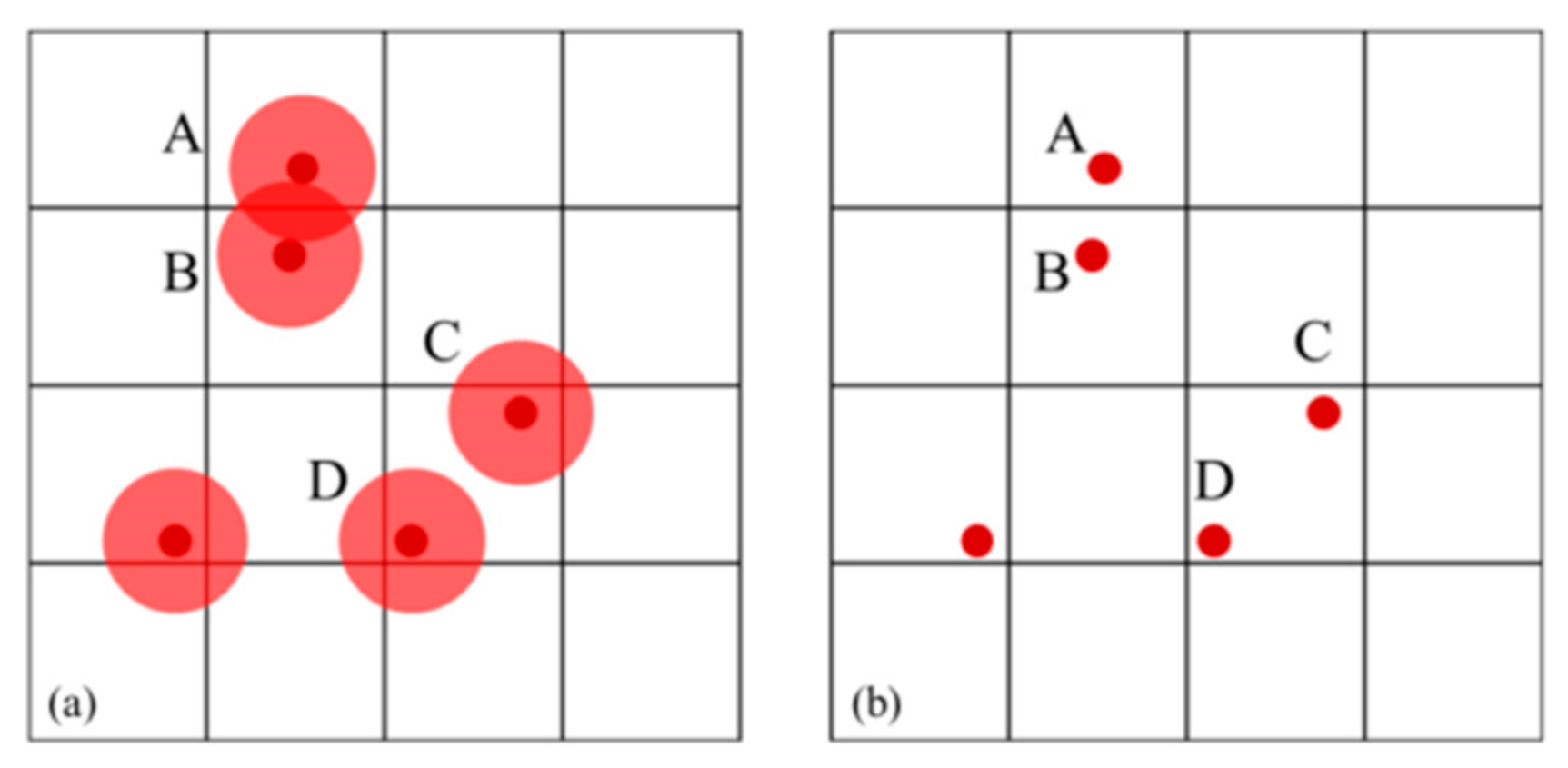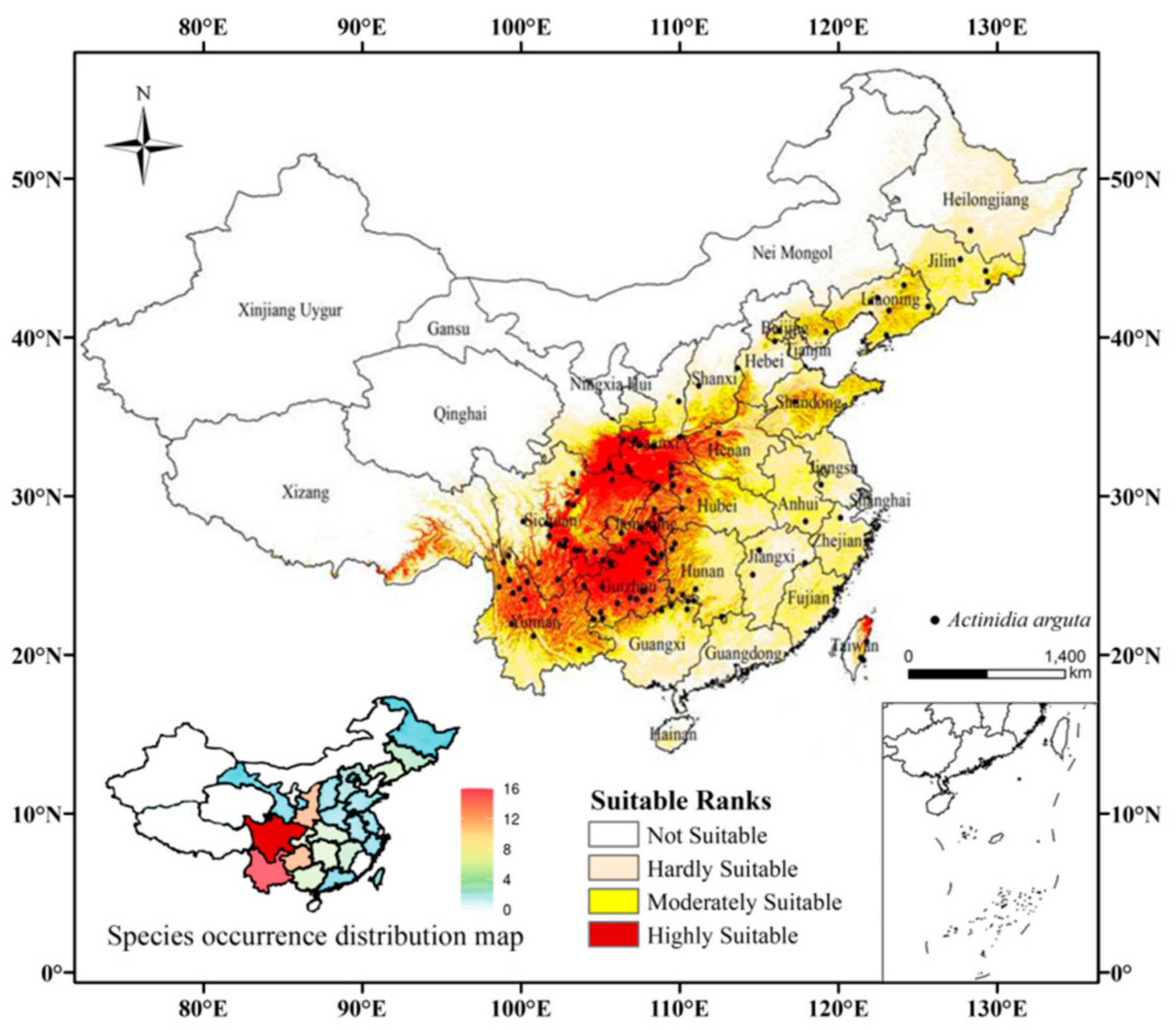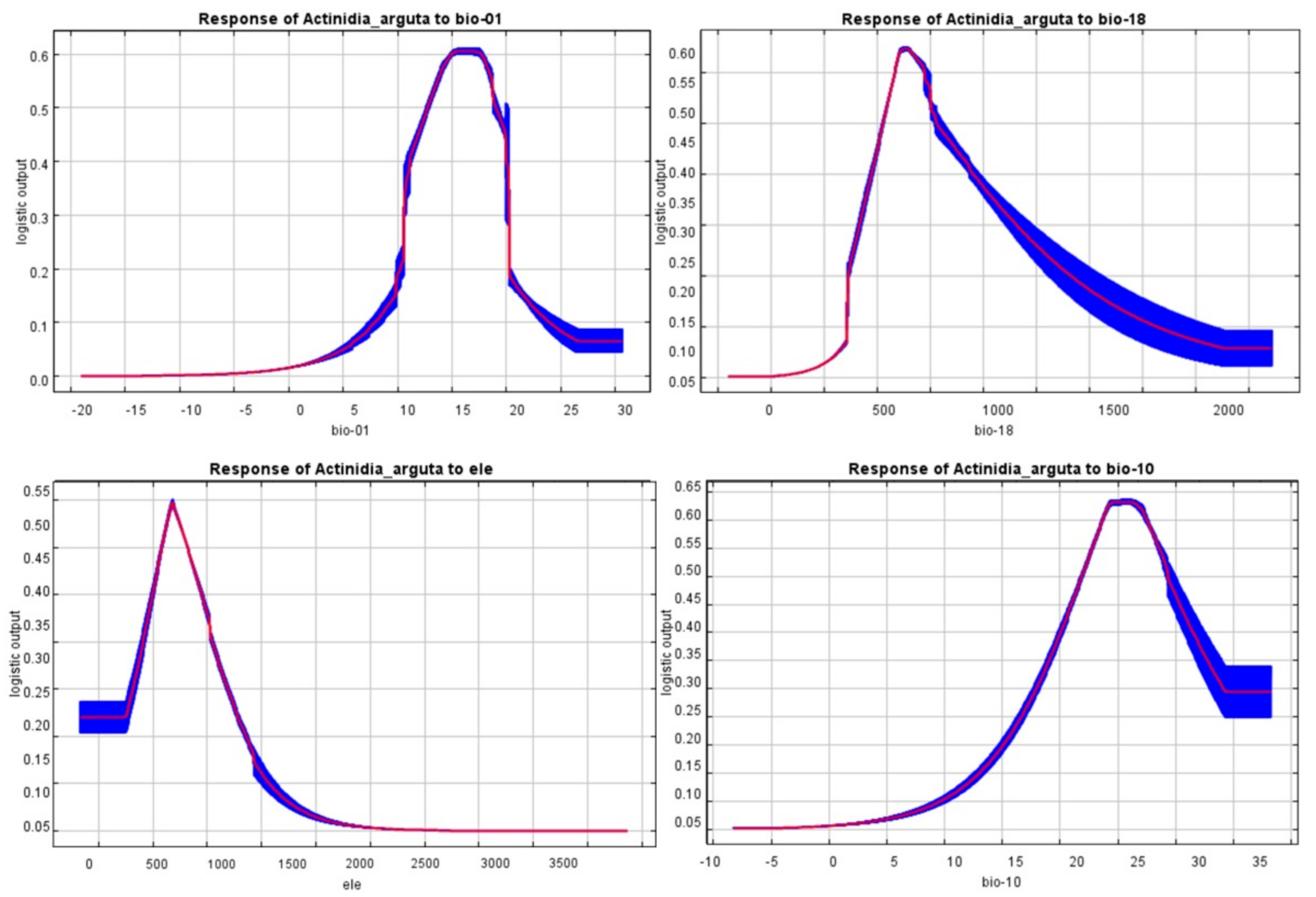Prediction of Potential Geographical Distribution Patterns of Actinidia arguta under Different Climate Scenarios
Abstract
:1. Introduction
2. Materials and Methods
2.1. Species Occurrence Records Collection
2.2. Environmental Variables
2.3. MaxEnt Model Evaluation
2.4. Species Potential Distribution and the Core Distributional Shifts
3. Results
3.1. Model Optimization Results and Contribution of Environmental Variables
3.2. Predicted Current Suitable Habitats
3.3. Predicted Future Suitable Habitats
3.4. The Core Distribution Shifts
4. Discussion
4.1. Environmental Variables Affecting the Potential Geographical Distribution
4.2. Effects of Future Climate Change on the Geographyical
4.3. Limitations of the Modeling Approach and Future Research Directions
4.4. A. arguta Industry’s Sustainable Development Prospects
5. Conclusions
Supplementary Materials
Author Contributions
Funding
Institutional Review Board Statement
Informed Consent Statement
Data Availability Statement
Conflicts of Interest
References
- Han, L.; Zhang, Q.; Ma, P.; Jia, J.; Wang, J. The spatial distribution characteristics of a comprehensive drought risk index in southwestern China and underlying causes. Theor. Appl. Climatol. 2016, 124, 517–528. [Google Scholar] [CrossRef]
- Birch, E.L. A Review of “Climate Change 2014: Impacts, Adaptation, and Vulnerability” and “Climate Change 2014: Mitiga-tion of Climate Change”. J. Am. Plan. Assoc. 2014, 80, 184–185. [Google Scholar] [CrossRef]
- Higgins, S.I.; Richardson, D.M. Predicting plant migration rates in a changing world: The role of long-distance dispersal. Am. Nat. 1999, 153, 464–475. [Google Scholar] [CrossRef] [PubMed]
- Zhao, J.; Yang, X.; Liu, Z.; Cheng, D.; Wang, W.; Chen, F. The possible effect of global climate changes on cropping systems boundary in China Ⅱ. The characteristics of climatic variables and the possible effect on northern limits of cropping systems in south China. Sci. Agric. Sin. 2010, 43, 1860–1867. (In Chinese) [Google Scholar] [CrossRef]
- Zhu, Y.; Wei, W.; Li, H.; Wang, B.; Yang, X.; Liu, Y. Modelling the potential distribution and shifts of three varieties of Stipa tianschanica in the eastern Eurasian Steppe under multiple climate change scenarios. Glob. Ecol. Conserv. 2018, 16, e00501. [Google Scholar] [CrossRef]
- Li, G.; Du, S.; Wen, Z. Mapping the climatic suitable habitat of oriental arborvitae (Platycladus orientalis) for introduction and cultivation at a global scale. Sci. Rep. 2016, 6, 30009. [Google Scholar] [CrossRef] [PubMed] [Green Version]
- Zhang, K.; Yao, L.; Meng, J.; Tao, J. Maxent modeling for predicting the potential geographical distribution of two peony species under climate change. Sci. Total Environ. 2018, 634, 1326–1334. [Google Scholar] [CrossRef]
- Wei, B.; Wang, R.; Hou, K.; Wang, X.; Wu, W. Predicting the current and future cultivation regions of Carthamus tinctorius L. using MaxEnt model under climate change in China. Glob. Ecol. Conserv. 2018, 16, e00477. [Google Scholar] [CrossRef]
- Liu, D.; Wang, R.; Gordon, D.; Sun, X.; Chen, L.; Wang, Y. Predicting Plant Invasions Following China’s Water Diversion Project. Environ. Sci. Technol. 2017, 51, 1450–1457. [Google Scholar] [CrossRef]
- Wang, C.; Hawthorne, D.; Qin, Y.; Pan, X.; Li, Z.; Zhu, S. Impact of climate and host availability on future distribution of Colorado potato beetle. Sci. Rep. 2017, 7, 4489. [Google Scholar] [CrossRef] [Green Version]
- Wu, H.; Ma, T.; Kang, M.; Ai, F.; Zhang, J.; Dong, G. A high-quality Actinidia chinensis (kiwifruit) genome. Hortic. Res. 2019, 6, 117. [Google Scholar] [CrossRef] [Green Version]
- Almeidaa, D.; Pintoa, D.; Santosa, J. Hardy kiwifruit leaves (Actinidia arguta): An extraordinary source of value-added compounds for food industry. Food Chem. 2018, 259, 113–121. [Google Scholar] [CrossRef]
- Wang, J.; Xu, L.; Wang, E.; Wang, J.; Xu, L. Editorial Board of Flora of China. In Chinese Academy of Sciences; Science Press: Beijing, China, 1995. [Google Scholar]
- Sanz, V.; L’opez-Hortas, L.; Torres, M.D.; Domínguez, H. Trends in kiwifruit and byproducts valorization. Trends Food Sci. Technol. 2021, 107, 401–414. [Google Scholar] [CrossRef]
- Kim, H.-Y.; Hwang, K.W.; Park, S.-Y. Extracts of Actinidia arguta stems inhibited LPS-induced inflammatory responses through nuclear factor-κB pathway in Raw 264.7 cells. Nutr. Res. 2014, 34, 1008–1016. [Google Scholar] [CrossRef] [PubMed]
- Kim, H.; Song, M.J. Analysis and recordings of orally transmitted knowledge about medicinal plants in the southern moun-tainous region of Korea. J. Ethnopharmacol. 2011, 134, 676–696. [Google Scholar] [CrossRef]
- Kwak, C.S.; Lee, J.H. In vitro antioxidant and anti-inflammatory effects of ethanol extracts from sprout of evening primrose (Oenothera laciniata) and gooseberry (Actinidia arguta). J. Korean Soc. Food Sci. Nutr. 2014, 43, 207–215. [Google Scholar] [CrossRef] [Green Version]
- Liu, Y.; Qi, Y.; Chen, X. Phenolic compounds and antioxidant activity in red- and in green-fleshed Kiwifruits. Food Res. Int. 2019, 116, 291–301. [Google Scholar] [CrossRef]
- Paturia, G.; Suzanne, M.H.; Shanthi, G.P. Kiwifruit drives human microbiota-derived DNA to stimulate IL-7 secretion in intestinal epithelial cells. J. Funct. Foods 2020, 67, 103882. [Google Scholar] [CrossRef]
- Zhu, H. Kiwifruit; China Forestry Publishing House: Beijing, China, 2009. [Google Scholar]
- Huang, G.H. Current Situation and Problems of Development of Actinidia arguta Industry. North. Fruits 2020, 1, 41–43, (In Chinese with English abstract). [Google Scholar] [CrossRef]
- Zhang, J.; Mo, Z.; Huang, S.; Guo, Z. Development of Kiwifruit industry in the world and analysis of trade and international competitiveness in China entering 21st century. Chin. Agric. Sci. Bull. 2014, 30, 48–55. (In Chinese) [Google Scholar]
- Latocha, P.; Lata, B.; Stasiak, A. Phenolics, ascorbate and the antioxidant potential of kiwiberry vs. common kiwifruit: The effect of cultivar and tissue type. J. Funct. Foods 2015, 19, 155–163. [Google Scholar] [CrossRef]
- Dan, L.W.; Richard, E.G.; Michael, T. ENMTools: A toolbox for comparative studies of environmental niche models. Ecography 2010, 33, 607–611. [Google Scholar] [CrossRef]
- Hijmans, R.J.; Cameron, S.E.; Parra, J.L.; Jones, P.G.; Jarvis, A. Very high resolution interpolated climate surfaces for global land areas. Int. J. Climatol. 2005, 25, 1965–1978. [Google Scholar] [CrossRef]
- Graham, M.H. Confronting multicollinearity in ecological multiple regression. Ecology 2003, 84, 2809–2815. [Google Scholar] [CrossRef] [Green Version]
- Van Vuuren, D.P.; Riahi, K. A proposal for a snew scenario framework to support research and assessment in different climate research communities. Glob. Environ. Chang. 2012, 22, 21–35. [Google Scholar] [CrossRef] [Green Version]
- Riahi, K. The Shared socioeconomic pathways and their energy, land use, and greenhouse gas emissions implications: An overview. Glob. Environ. Chang. 2017, 42, 153–168. [Google Scholar] [CrossRef] [Green Version]
- Phillips, S.J.; Anderson, R.P.; Schapire, R.E. Maximum entropy modeling of species geographic distributions. Ecol. Model. 2006, 190, 231–259. [Google Scholar] [CrossRef] [Green Version]
- Wasowicz, P.; Pálsson, S.; Pasierbiński, A.; Wierzgoń, M.; Ólafsson, E.; Heiðmarsson, S.; Przedpelska-Wasowicz, E.M. Alien or native? Examining a case of Melampyrum pratense in Iceland. Polar Biol. 2018, 41, 1725–1735. [Google Scholar] [CrossRef]
- Merow, C.; Smith, M.J.; Silander, J.A. A practical guide to MaxEnt for modeling species’ distributions: What it does, and why inputs and settings matter. Ecography 2013, 36, 1058–1069. [Google Scholar] [CrossRef]
- Elith, J.; Phillips, S.J.; Hastie, T.; Dudík, M.; Chee, Y.N.; Yates, C.J. A statistical explanation of MaxEnt for ecologists. Divers. Distrib. 2011, 17, 43–57. [Google Scholar] [CrossRef]
- Muscarella, R.; Galante, P.J.; Guardia-Soley, M.; Boria, R.A.; Kass, J.M.; Uriarte, M.; Anderson, R.P. ENMeval: An R package for conducting spatially independent evaluations and estimating optimal model complexity for Maxent ecological niche models. Methods Ecol. Evol. 2014, 5, 1198–1205. [Google Scholar] [CrossRef]
- Swets, J.A. Measuring the Accuracy of Diagnostic Systems. Science 1988, 240, 1285–1293. [Google Scholar] [CrossRef] [Green Version]
- Brown, J.L. SDMtoolbox: A python-based GIS toolkit for landscape genetic, biogeographic and species distribution model analyses. Methods Ecol. Evol. 2014, 5, 694–700. [Google Scholar] [CrossRef]
- Brown, J.L.; Bennett, J.R.; French, C.M. SDMtoolbox 2.0: The next generation Python-based GIS toolkit for landscape genetic, biogeographic and species distribution model analyses. PeerJ 2017, 5, e4095. [Google Scholar] [CrossRef] [Green Version]
- He, Q.; Zhou, G.; Lü, X.; Zhou, M. Climatic suitability and spatial distribution for summer maize cultivation in China at 1.5 and 2.0 °C global warming. Sci. Bull. 2019, 64, 690–697. [Google Scholar] [CrossRef] [Green Version]
- Qu, Z.; Zhou, G. Regionalization of Climatic Suitability for Major Kiwifruit Cultivars in China. Chin. J. Agrometeorol. 2017, 38, 257–266. (In Chinese) [Google Scholar] [CrossRef]
- Zhong, M.; Zhang, W.; Huang, C.; Tao, J.; Qu, X.; Han, W.; Xu, X. Effects of High Temperature Stress on Related Heat-resistance Index in Kiwifruit Seedlings. Hubei Agric. Sci. 2018, 57, 96–99. (In Chinese) [Google Scholar] [CrossRef]
- Liu, X. Questions and Answers on High Quality Cultivation of Kiwifruit; China Agricultural Publishing House: Beijing, China, 2009. [Google Scholar]
- Peterson, A.T. Predicting the geography of species invasions via ecological niche modeling. Q. Rev. Biol. 2003, 78, 419–433. [Google Scholar] [CrossRef] [PubMed] [Green Version]
- Lambers, J.H.R. Extinction risks from climate change. How will climate change affect global biodiversity? Science 2015, 348, 501–502. [Google Scholar] [CrossRef] [PubMed]
- Román-Palacios, C.; Wiens, J.J. Recent responses to climate change reveal the drivers of species extinction and survival. Proc. Natl. Acad. Sci. USA 2010, 117, 4211–4217. [Google Scholar] [CrossRef]
- Dai, S.; Li, H.; Liu, H.; Liu, E. The spatio-temporal change characteristics of agriculture climate resources in southern China under the background of global warming. Chin. J. Agric. Resour. Reg. Plan. 2014, 35, 52–60, (In Chinese with English abstract). [Google Scholar] [CrossRef]
- Wang, X.; Jiang, D.; Lang, X. Temperature and Precipitation Changes over China under a 1.5℃ Global Warming Scenario Based on CMIP5 Models. Chin. J. Atmos. Sci. 2019, 43, 1158–1170. (In Chinese) [Google Scholar] [CrossRef]
- Zhong, L.; Ma, Y.; Salama, M.S.; Su, Z. Assessment of vegetation dynamics and their response to variations in precipitation and temperature in the Tibetan Plateau. Clim. Chang. 2010, 103, 519–535. [Google Scholar] [CrossRef]
- Ren, D.; Qi, Y.B.; Yu, W.Y.; He, Y.; Deng, X.; Fu, L. Research on the degree of use and the Influencing factors of farmers’ machinery-based on the survey of 205 huseholds of kwifruit frmers in Sichuan Province. J. Sichuan. Agric. Univ. 2016, 34, 528–534. [Google Scholar] [CrossRef]
- Wu, J.; Zhou, Q.; Li, Y. Strategies of Adaptation to Climate Change for Biodiversity in China. Chin. Popul. Resour. Environ. 2011, 21, 435–439. (In Chinese) [Google Scholar]








| Code | Environmental Variable | Unit | Percentage Contribution (%) | Permutation Importance (%) |
|---|---|---|---|---|
| bio_1 | Annual Mean Temperature | °C | 37.8 | 18.9 |
| bio_4 | Temperature Seasonality | unitless | 2.7 | 0.4 |
| bio_5 | Max Temperature of Warmest Month | °C | 4.2 | 0.5 |
| bio_10 | Mean Temperature of Warmest Quarter | °C | 7.9 | 6.1 |
| bio_18 | Precipitation of Warmest Quarter | mm | 26.5 | 23.4 |
| wind5-6 | Average wind speed from May to June | m/s | 2.9 | 9.1 |
| ELE | Elevation | m | 9.5 | 6.0 |
| ASP | Aspect | unitless | 5.3 | 8.7 |
| t_clay | Percentage of clay in the topsoil | wt.% | 1.8 | 2.1 |
| t_ph | pH in the topsoil | unitless | 0.5 | 13.4 |
| t_oc | Organic carbon content in the topsoil | g/kg | 0.9 | 1.9 |
| FC | RM | Mean Delta.AICc | Mean AUC.diff | Mean OR10 | Mean AUC |
|---|---|---|---|---|---|
| L | 3.5 | 152 | 0.0042 ± 0.001 | 0.1057 ± 0.015 | 0.805 ± 0.002 |
| LQ | 3 | 45 | 0.004 ± 0.002 | 0.1057 ± 0.001 | 0.825 ± 0.018 |
| H | 3 | 32 | 0.0052 ± 0.001 | 0.1103 ± 0.002 | 0.837 ± 0.012 |
| LQH | 2 | 9 | 0.0078 ± 0.003 | 0.1148 ± 0.001 | 0.84 ± 0.0021 |
| LQHP | 1 | 26 | 0.0102 ± 0.002 | 0.1498 ± 0.008 | 0.891 ± 0.016 |
| LQHPT | 2 | 0 | 0.0091 ± 0.001 | 0.1192 ± 0.004 | 0.921 ± 0.013 |
Publisher’s Note: MDPI stays neutral with regard to jurisdictional claims in published maps and institutional affiliations. |
© 2021 by the authors. Licensee MDPI, Basel, Switzerland. This article is an open access article distributed under the terms and conditions of the Creative Commons Attribution (CC BY) license (http://creativecommons.org/licenses/by/4.0/).
Share and Cite
Ma, Y.; Lu, X.; Li, K.; Wang, C.; Guna, A.; Zhang, J. Prediction of Potential Geographical Distribution Patterns of Actinidia arguta under Different Climate Scenarios. Sustainability 2021, 13, 3526. https://doi.org/10.3390/su13063526
Ma Y, Lu X, Li K, Wang C, Guna A, Zhang J. Prediction of Potential Geographical Distribution Patterns of Actinidia arguta under Different Climate Scenarios. Sustainability. 2021; 13(6):3526. https://doi.org/10.3390/su13063526
Chicago/Turabian StyleMa, Yining, Xiaoling Lu, Kaiwei Li, Chunyi Wang, Ari Guna, and Jiquan Zhang. 2021. "Prediction of Potential Geographical Distribution Patterns of Actinidia arguta under Different Climate Scenarios" Sustainability 13, no. 6: 3526. https://doi.org/10.3390/su13063526






